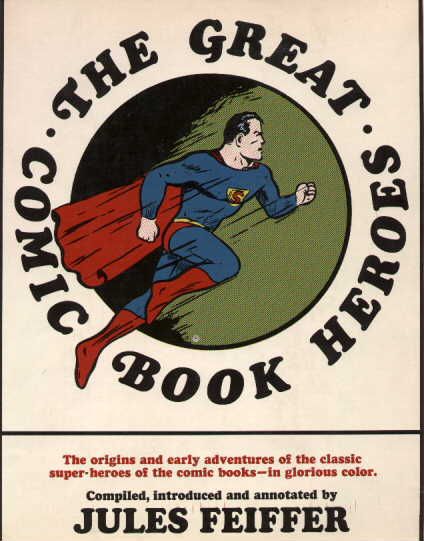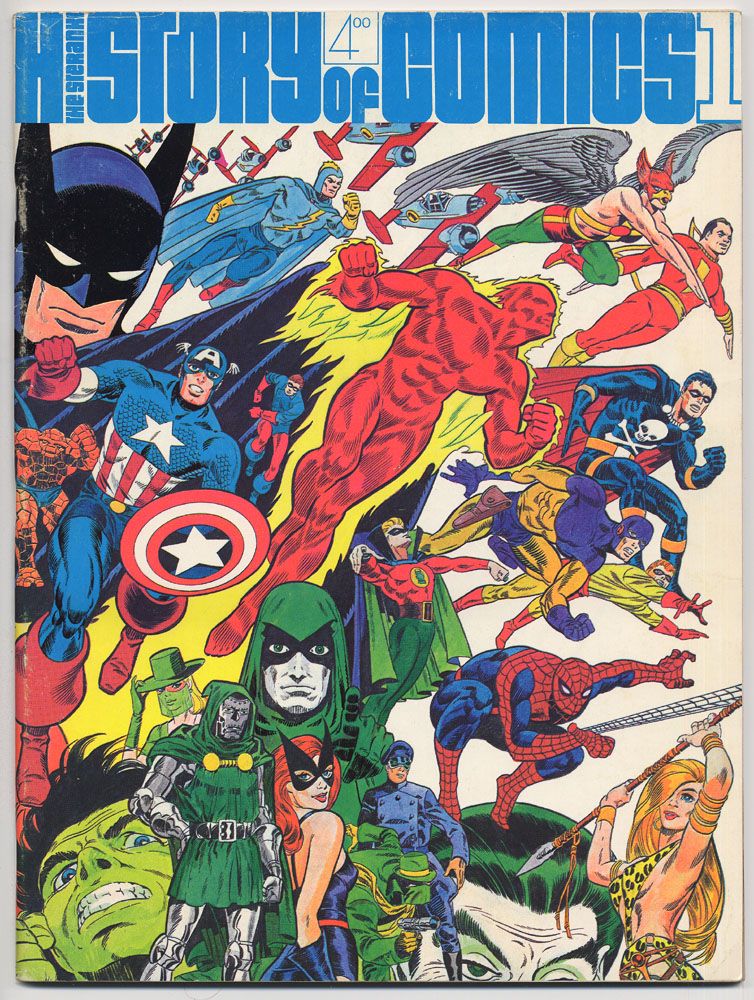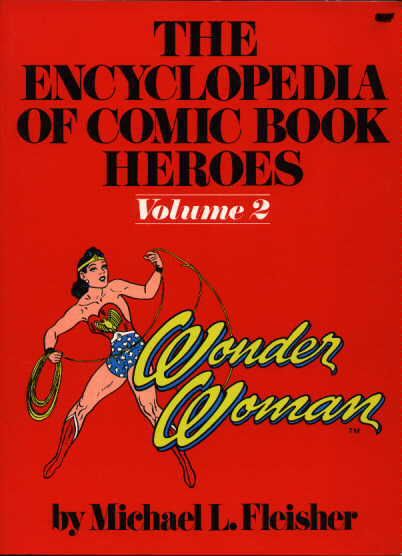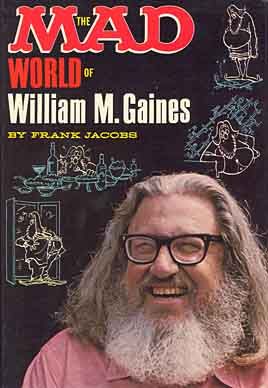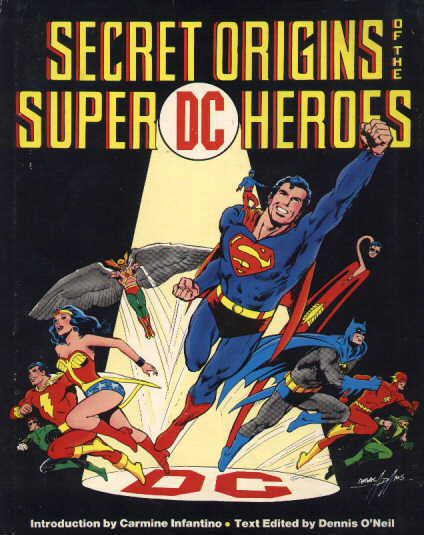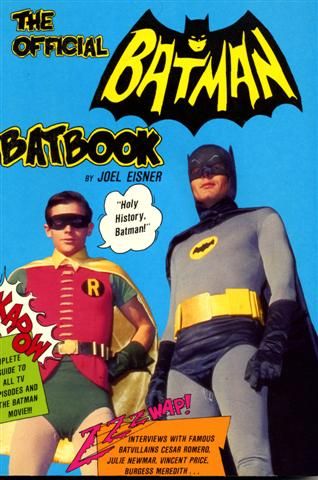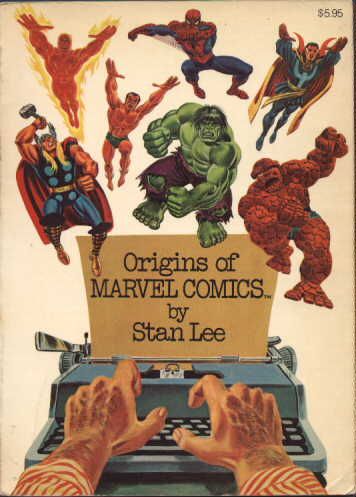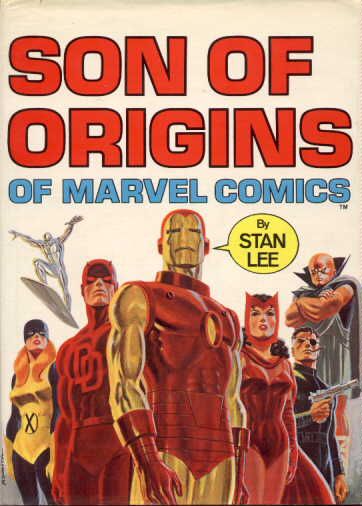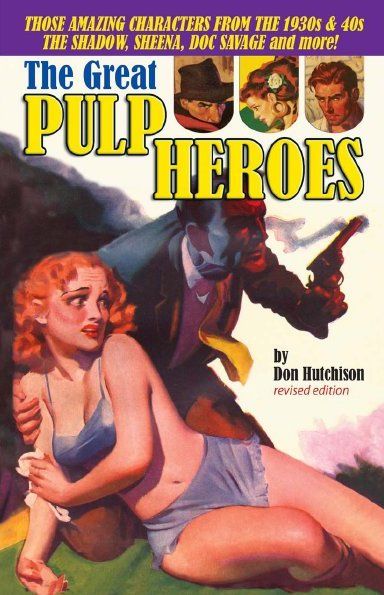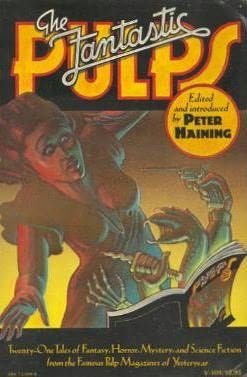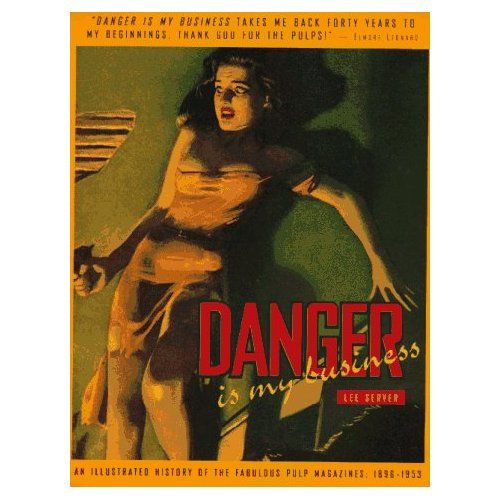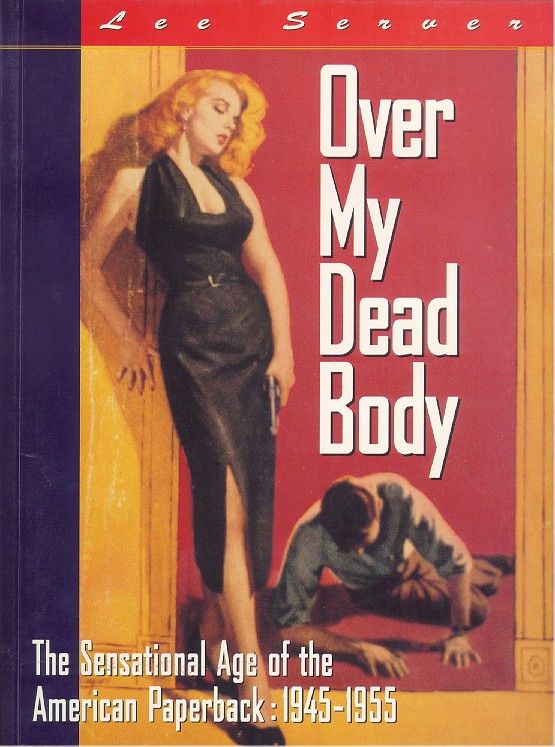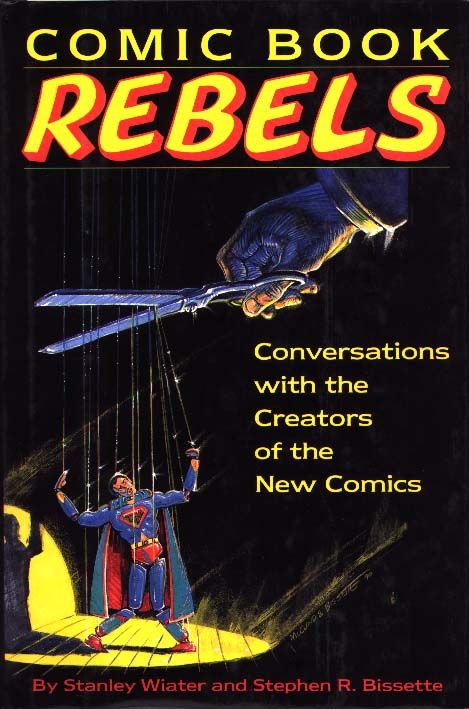It amuses my wife Julie, and several of our friends, to suggest that I know everything there is to know about comics, pulps, and junk culture in general. And I will freely admit that I do have a head full of that kind of minutiae -- I mean, I'm no Mark Evanier or anything, but I've got some game.
Truthfully, though, especially if you have a writing gig like this one, you better be able to look things up. Of course the internet itself is an invaluable resource, and I use it a lot, but it's nice to have actual comics history and reference books on hand, too. A few weeks ago, someone suggested taking a look at some of these scholarly (and some not-so-scholarly) works out there about comics. So here it is.
These are by no means ALL of them. They're just the ones I own and would recommend. If your personal favorite's not listed here, well, it's probably on my shopping list (I still need to order Spurgeon and Raphael's Stan Lee biography and Evanier's upcoming Jack Kirby book, for example.)
This library gets added to almost as often as the actual comics collection. I'm endlessly fascinated with comic books and pulp fiction as an artform, as a pop culture phenomenon, as a societal mirror... and you know, there are lots of cool books out there about all those things. As far as popular culture historians are concerned, we are living in a renaissance of scholarship.
The first one of these I encountered is still one of my favorites.
This is the original edition. In its first, mid-sixties incarnation, The Great Comic Book Heroes reprinted a wonderful collection of Golden Age stories including the origin tales of Superman, Batman, Captain America, Flash, Green Lantern, and Plastic Man, as well as stories featuring the Spectre, the original Human Torch, and the Spirit. I first saw this book in a B.Dalton's in 1972 and I devoured it IN THE STORE. The comics reprints, anyway. For an eleven-year-old "the words part" in the front was just in the way.
Years later, in college, I acquired a copy of my own, and with the patience of adulthood I discovered the "words part" from Feiffer that framed the reprints was well worth my time as well. By turns funny and insightful, The Great Comic Book Heroes is both an analysis and a memoir of the Golden Age superheroes from their beginnings in the 1930's up through the attacks by Dr. Frederic Wertham.
There's a new edition (omitting the comics reprints) from Fantagraphics, and I certainly would recommend that as well. Even with just Feiffer's text, it's worth having in any incarnation. But -- it must be said -- even though I can't blame Fantagraphics for not wanting to go through all the clearances hassle with so many Archive Editions and so on available to collectors today, still... the older edition with the reprints is much more fun. Try eBay or Amazon or even Heritage Auction Galleries. Though the word's out on the original edition and rare-book collectors tend to drive the price up (come to think of it, this column probably isn't helping) you still sometimes get lucky. Try a used-bookstore search engine like Alibris or Bookfinder.com and see what you turn up.
Feiffer's book is great fun but I wouldn't rank it as the BEST history of Golden Age superhero comics. The one that I think is absolutely the one to beat is, sadly, incomplete.
Unfortunately Jim Steranko's History of Comics only reached volume two before it was over (I'm pretty sure it was projected to go longer) but he still covered an amazing amount of ground in those two volumes. Volume one was an overview of comic books' origin in newspaper strips, a chapter on pulp heroes' influence, then chapters on Superman, Batman, Captain America, Namor and the Torch and the other Timely heroes, the JSA, and the kid-gang comics like Boy Commandos and Newsboy Legion. Volume two covered the Marvel Family and the other Fawcett heroes, the Blackhawks, other flying heroes like Airboy and Captain Midnight, Plastic Man, the Quality stable of heroes like Doll Man and Uncle Sam, and wrapping up with Eisner and the Spirit. Exhaustively researched and profusely illustrated with examples of covers and interior page art, and all delivered with two magnificent wraparound covers by Steranko himself.
Since it came out in 1972, and Steranko himself was in the business, an additional bonus was that many of the artists under discussion were still alive and Jim Steranko was able to get hold of them and ask them things. As a result it's got a lot of first-hand accounts of inside stuff that you just don't see in other books about the Golden Age. It's simply the best overall history of superhero comics' Golden Age I've ever run across.
So, naturally, it's out of print. Sorry. These days it's usually an exorbitantly-priced collector's item. But if you see it, grab it -- sometimes they'll turn up at a convention or something. I happen to know that Zanadu Comics in downtown Seattle has two or three copies of volume 2. ("Warehouse find," Howard tells me.) They've got them much more reasonably priced than you'd see on eBay. And I really, REALLY recommend the book. I bet if you sent an e-mail they'd be happy to work out some kind of mail-order thing if you're not in town.
Speaking of incomplete histories, I talked about Michael Fleisher's Encyclopedias in this space a few weeks ago...
But this is as good a time as any to remind everyone that DC's bringing the Batman, Wonder Woman, and Superman volumes back into print.
I glanced through the new edition at the store last week and it looks nice. Recommended, as long as you remember it's a reference work and a little on the dry side.
For those that are interested in EC, the flap with Dr. Wertham that resulted in the Comics Code, and the beginning of Mad Magazine, I really like this book.
Frank Jacobs worked at Mad with Gaines and was able to talk extensively with him, Al Feldstein, and all the other Madmen. I've always regarded this as pretty much the final word on the subject. Although -- full disclosure -- I haven't seen Mark Evanier's new book about Mad, and knowing Evanier, that's probably pretty good too. But get the Jacobs book first.
This brings us to the Silver Age, more or less. There are several books covering this era that I'm very fond of.
This is an interesting book -- again, sadly, out-of-print -- that reprints, side-by-side, the Golden Age origin and then the Silver Age reboot of most of DC's mainstays. The framing text from Denny O'Neil is brief, hardly more than a few paragraphs before each character's reprint chapter, but nevertheless is really informative and raises this effort above just a trade paperback reprint book. Worth hunting down.
Just as an aside, as long as we're discussing mid-sixties superheroes we should at least acknowledge the elephant in the room, considering how much fan anger and agony has been spent on the subject.
Love it or hate it, the Adam West Batman television show had a huge impact on superhero comics at the time, and its influence was felt for years afterward as superhero creators struggled to get AWAY from the imprint it made in the national consciousness. What often gets lost, in all that kerfluffle over its influence on the public opinion of superhero comics, is that it really was a smart, funny satire, especially in its early episodes. I found Joel Eisner's Official Batman Batbook to be a breezy, entertaining look at the series and an easy-to-use reference and episode guide. The various reminiscences from the show's guest stars, writers and producers make it well worth picking up. (Conspicuously absent is any commentary from Adam West or Burt Ward themselves, probably because they were saving it for their own hack-writer ghosted memoirs. Skip those and get this instead.)
And there are Stan Lee's tales of Marvel's early years, again framing reprints of origin stories.
Fans have argued themselves blue in the face over how accurate Stan's recollections are, and Stan himself has often said his memory is notoriously bad. But the fact remains that these are really fun books.
I like the first two, Origins and Son of Origins, the best. These two books did well enough that Fireside Books did a whole series of trade paperbacks with Stan and the Marvel characters. There were also Bring On The Bad Guys, The Superhero Women, and books individually about the Fantastic Four, Spider-Man, the Hulk, Captain America, and Dr. Strange. I own some of these too but really you can't call them references. Although they are very cool.
Marvel's brought revised editions of some of these out again recently (with what I consider to be vastly inferior covers) but still, they're worth picking up. Try for the originals with those great painted covers by John Romita Senior, though.
When it comes to straight history books about the Silver Age, though, I prefer Jacobs and Jones' The Comic Book Heroes.
The first edition starts with Julius Schwartz rebooting the Flash and goes on up through the 1980's, with looks at the Claremont-Byrne X-Men, the new Teen Titans, and Frank Miller's Daredevil. Jones did a revised, updated edition a few years later that includes the beginnings of Image Comics and the boom-and-bust of the collectibles hysteria in the early 1990's. The new edition is quite a bit more personal in the latter half, since Jones had himself gone on to write for DC and Marvel in the 90's and his experience colors those chapters. Still, even though it's more of a memoir in places than some would like, I own and use both editions as references... and I find both books entertaining reads just as books, which is always a plus.
And of course most of you reading this have probably already heard of Jones' follow-up, Men of Tomorrow.
Everybody in and around comics has already praised this to the skies, so I'll confine myself to a quick Me Too! What They Said! It's good, it's well-researched, and if you are interested in comic books you should read it. Period.
Les Daniels has done a number of really nice coffee-table books about comics and their history, but I like this first one the best. Lots of good Silver and Bronze Age stuff in here.
Comix starts with comics at the very beginning, with the Yellow Kid, and goes forward from there. It has chapters covering EC, the early years at Marvel, and the undergrounds, among other things. My personal feeling is that Daniels' follow-up efforts, as pretty as they are, tend to be a bit lightweight; I know that sounds ridiculous considering they're usually the size of an end table, but to me they're books that are meant to be looked at, admired as artifacts, rather than actually read. But his first one spoiled me. Your mileage may vary.
I love pulp fiction in all its forms, and I am a sucker for books about the history of superhero comics' predecessors, as well. Of those, this is probably my favorite.
I use this more than any other when I'm trying to confirm my memory on this or that point for whatever article I'm working on. The amazing thing is that I had no idea it existed; it was a gift from a writer friend of mine, Nancy Rue.
It's kind of a funny story. She was in the middle of a series of young-adult novels taking place during different periods of American history, and she thought it would be fun to have her characters in the 1930's books collect and read comics. So she called me, her go-to guy on all matters concerning comics and junk culture, to find out what superheroes 1930's kids would collect.
"There's a problem," I told her. "Super heroes didn't really get going until '38 and '39. There were no superhero comics in 1935. Chances are your nerd kid would have been reading the pulp magazines instead."
"What are pulps?"
So I gave her the quick sketch and suggested a couple of books. She didn't get those, but instead found Don Hutchison's book at Amazon, which was vastly superior to anything I recommended. And she sent it to me as a thank-you gift when her novel was done.
In my defense, the books I DID recommend were pretty good too. This is another favorite of mine.
Peter Haining published this anthology in the 1970's, and it's simply wonderful. It's a collection of short stories from pulp pioneers as diverse as Jack London, Ray Bradbury, and Dashiell Hammett, but the great thing is that he introduces each one by including an amazing amount of historical material. Plus it includes as an appendix the wonderful reminiscence Charles Beaumont wrote about "The Bloody Pulps" for Playboy in 1962.
Haining also did this book as well, which I haven't yet acquired but it's coming sometime in the next couple of weeks. (I always find something to spend a couple of bucks on when I'm researching the column. It's not really a paying gig when you factor that part in.) Even sight unseen, I expect good things, though. Haining's got enough of a track record with me -- I have a number of his other fiction anthologies here -- that I'll plug the book here.
The other one I originally suggested to Nancy was Lee Server's delightful Danger Is My Business.
This one's more of a history book, but with breathtaking color reproductions of various pulp covers scattered throughout. A really high-end art book, and a treat even if you know nothing about pulp fiction.
He has a follow-up that's tremendous fun too.
I mention it here mostly because people seemed to enjoy the column about trash spinner-rack paperbacks I did a while ago. If that's your thing, believe me, you'll love Server's Over My Dead Body. Certainly I did.
There are a couple of other ancillary books I wanted to recommend, too. I don't know that they qualify as scholarly works, but I think Mark Evanier's three essay collections pictured here are well worth the time.
These are compulsively readable, entertaining books. They are mostly composed of columns that Evanier originally wrote for Comics Buyer's Guide, but in many cases he's extensively revised and extended them for the book edition. Just plain fun. From TwoMorrows.
I also wanted to give a quick recommendation to these two "biographies" of America's most famous cop.
See, it says so right on the cover!
Seriously, they're both terrific books and you probably could find them used or remaindered on Amazon for chump change. Both are extensively illustrated with actual strips and panels from Chester Gould's strip and they'd make lovely companion pieces for the new Complete Dick Tracy collections coming out now from IDW Publishing.
And finally, just for sentimental reasons, I want to mention the first newspaper strip collection/history book I ever bought.
I fell in love with this book in the sixth grade and I mowed lawns relentlessly for two months to scrape together the $7.95 it cost to buy it. (It pains me to think how little money that seems like today; trust me, back then it was huge.) I was already smarting over having missed the Feiffer book at B.Dalton's and I was determined to never have that happen again. (Shopping for books was much more of a hunt, in those pre-online ordering days.) It's pretty much the only reason I watched the TV show with Gil Gerard.
And you know what? I'd still recommend it and I certainly still treasure mine. It collects the very first Buck Rogers strips, as well as some alarmingly racist ones from World War II, on up through some later Atomic-Age entries. And there's lots of fun extras including one of the radio-show scripts and a terrific essay by Ray Bradbury. This one, like the Feiffer book, tends to go high on eBay and from dealers but it's worth hunting down.
That's probably enough, I think. I could go on and on -- there's the Modern Masters and Companion series from TwoMorrows, various historical collections and critical overviews from Fantagraphics, and so on...
But I have a hunch you all are familiar with those already. And all this book talk has got me wanting to go cruise Amazon myself and see what's new. I better quit before I spend any more money.
See you next week.


